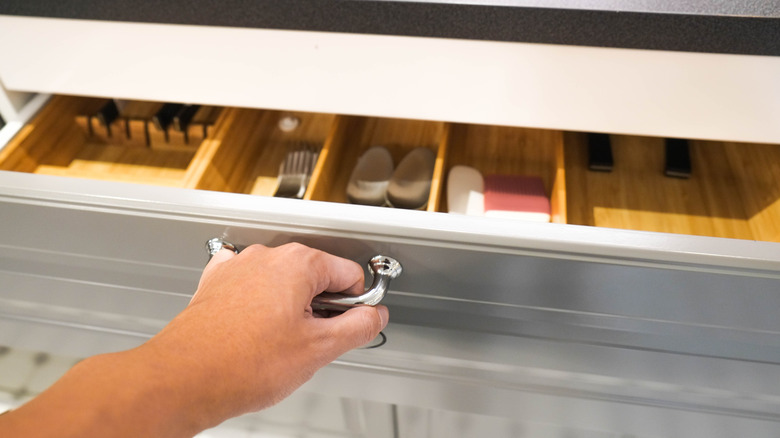How To DIY Drawers And Pull-Out Shelves For Your Cabinets
We may receive a commission on purchases made from links.
Are you growing fed up with the annoying fixed shelves in your cabinets? Imagine how much more useful the cabinets would be if the shelves could pull out or retract, so you could reach all the items easily. Or, just think how handy it would be if the cabinets simply had drawers instead, which would improve accessibility and capacity. The good news is that if you have some basic home woodworking tools, a few pieces of plywood, and aren't afraid of a challenge, you can make your own DIY drawers or pull-out shelves.
Now, making pull-out shelves and building drawers aren't necessarily beginner woodworking projects. The main obstacle to success is measurements — you'll need to make sure that the units you construct have sufficient clearance to slide out and retract back into the cabinet. Putting the drawer boxes together and installing them, on the other hand, is more straightforward, while adding pull-out shelves is even more of a breeze.
To make the process as smooth as possible, make sure you have all the right equipment on hand, including at least a power saw, a drill with driver bits, some wood adhesive, and protective gear like goggles and gloves. Below, we'll show you how to measure and build pull-out cabinet drawers, and key things to watch out for during installation.
How to build the pull-out drawers or shelves
If pull-out shelves will suffice, you have two options. First, you can tweak the existing shelves to receive slides. Measure the width of the slides, cut the sides of the shelves to allow enough clearance, and adhere some thin plywood strips to the edge. Alternatively, buy ready-made pull-out shelves like these ones on Amazon if they match the cabinet dimensions.
If you'd like to upgrade your cabinets with drawers, determine the drawer dimensions. Measure the sides and back of the cabinet, and factor in the clearance needed for side-mount slides. This is usually around half an inch, but may be more if there's vertical framing on the cabinet's side panels. Next, consider the materials. Plywood makes a great choice for the drawer boxes. The size is entirely up to you. For example, you can make the bottom and sides with ½-inch ply, or keep the thicker bits for the sides and use ¼-inch ply on the bottom.
Start by making the drawer vertical panels by ripping the plywood sheets to achieve the desired height. Then, cut the resulting long pieces to the cabinet's depth and length dimension, accounting for the overlap between the front, back, and side panels. If you know how to make perfect pocket holes, use this method to screw the side panels together. Meanwhile, you can nail, screw, or glue the bottom to the sides, or make dado cuts on the side panels and size the bottom to fit them.
How to install the shelves or drawers inside the cabinet
First, have a look inside the cabinet. Since it didn't come with pull-out features originally, chances are that it has some excess framing that will get in the way of your shelves or drawers. For one, the cabinet probably has a stile — a narrow vertical front panel that conceals the gap between the two doors. As you can imagine, this stile will not only make installation impossible, it will also prevent shelves or drawers from sliding out. Simply cut it out at the top and bottom. If you're installing glide-out shelves, glue this strip onto one of the doors so that there's no gap between them (you may need to take the door off its hinges to make this step easier).
Next, check if there's any framing on the cabinet's side panels — there are usually narrow vertical blocks at the front near the door hinges. Whether you're adding shelves or drawers, these pieces will prevent you from pulling them out. Now, you can't just remove them, so instead, you'll need to attach mounting supports that sit flush with these framing members. If you need these supports, measure the width of the obstructing framing piece and cut planks to match the size before attaching them to the cabinet. Now, you can fasten the cabinet portions of the drawer slide to these supports on either side. Finally, screw on the slide to the sides of the shelves or drawer box panels, and insert the new units into the cabinet.
